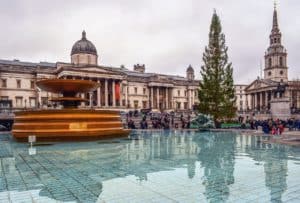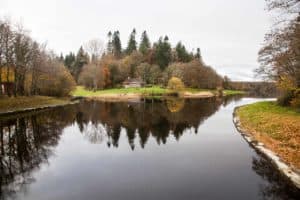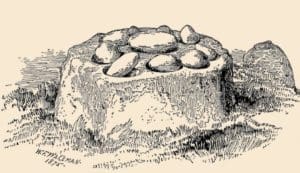The Role of Fairies in Irish and Scottish Lore: Cultural Significance and Legends

Updated On: April 17, 2024 by Esraa Mahmoud
In the tapestries of Irish and Scottish lore, fairies have been ever-present, weaving their presence into cultural narratives and the natural environment. The mythology of these mysterious beings carries a resonance that extends far beyond mere stories; it reflects a deep-rooted belief system known as the fairy faith.
This faith coloured interactions with the unseen world, where every well, loch, and thicket might house the ‘wee folk’, and every unexpected twist in life’s journey could be attributed to their unseen hands.
Fairies in these traditions are more than just whimsical storybook creatures; they embody the essence of the lands they inhabit and the communities that tell their tales. Their roles vary from protective guardians of nature to mischievous, sometimes malevolent entities to be respected—or feared.
The belief in fairies was a serious matter, one that informed a wide variety of cultural practices, from leaving offerings to avoid fairy wrath to consulting them in matters of love and prosperity. Irish and Scottish folklore is rich with accounts of interactions with fairies, from the benevolent to the vengeful, painting a complex picture of the ‘good folk’ and their impact on human lives.
Historical Development of Fairy Lore

Fairy lore has undergone a significant evolution, transitioning from its Pagan origins and adapting to Christian influences, all while being sustained through an enduring oral tradition. We shall explore these facets and their effect on the Gaelic myths that often feature fairies and goddesses.
From Pagan Roots to Christian Influences
Initially, fairies in Irish and Scottish lore were closely connected to the Pagan beliefs of the Celts. They were often seen as deities or spirits of nature—a belief echoing the reverence ancient Celts had for the land and the supernatural beings that inhabited it. With the advent of Christianity, these beings were not erased but rather assimilated into the new religious context.
The transition from Paganism to Christianity saw fairies often taking on roles within Christian narratives. It was a delicate blending where the power of the fairies was acknowledged in a Christian world, yet they remained a distinct and separate part of folklore.
Oral Tradition and the Preservation of Stories
Irish and Scottish communities kept fairy tales alive through oral traditions. These stories were passed down through generations, ensuring that the essence of the lore was not lost. The Gaelic language itself became a vessel for these tales, imbuing them with the cadences and nuances specific to the culture.
Certain characters, such as the goddesses of old, transitioned into fairy characters, maintaining a feminine mystique and influence within the tales. The persistence of the oral tradition helped preserve these stories even in the face of societal changes that would otherwise have led them to be forgotten.
Key Elements of Fairy Mythology
Fairy mythology is an integral part of both Irish and Scottish lore, featuring a range of beings with varying degrees of power and purpose. These entities, deeply woven into the fabric of Celtic culture, often serve as a bridge between the natural world and the mystical.
Defining Fairies in Lore
Fairies, as we understand them within Irish and Scottish folklore, often defy the typical portrayal of small, winged creatures. Instead, they are imbued with a more complex nature, blending elements of the ancient with the ethereal. In these traditions, fairies can be benevolent or malevolent, subtle or powerful, yet always remain connected to the forces of nature and the land.
The Sidhe and Other Fairy Beings
The Sidhe—pronounced ‘shee’—are perhaps the most renowned of the fairy folk in Celtic mythology. Descendants of the Tuatha Dé Danann, these beings inhabit a parallel existence to humans, dwelling in ancient mounds and hills. Other fairy beings, such as the Daoine Sidhe play a significant role within folklore, often depicting the fairies as protectors of the natural world, yet also as tricksters who might lead the unwary astray.
Mythological and Ulster Cycles
The Mythological Cycle recounts the arrival of the Tuatha Dé Danann in Ireland and their subsequent battles with other supernatural forces. These stories establish the framework for understanding the hierarchy and powers of the fairy world. Similarly, the Ulster Cycle is rich with tales of heroes like Cú Chulainn, whose interactions with fairy folk reveal the interconnection between mortals and fairy beings and how they influence each other’s fates.
Fairies and the Natural World
In exploring the role of fairies within Irish and Scottish lore, we find that our natural environment, from the depths of the forests to the tranquillity of waterways, is often seen as intertwined with the fairy realm. These elemental spirits have been thought to dwell within the Earth’s most enchanting corners, marking the land with mystery and magic.
Fairies’ Connection to the Earth and Forest
Fairies are deeply connected to the earth and forests, embodying the vital spirit of nature’s wild, undisturbed places. The ancient Celts believed that fairies, like the Irish Sidhe, resided in mounds and hills found within the green forests. These natural formations were more than mere habitats; they were gateways to a mystical dimension where fairies lived freely, overseeing the cycle of growth and decay that maintains the balance of the natural world.
Waterways and Lochs as Fairy Dwellings
Equally sacred to fairies are the waterways and lochs. Scottish lore is replete with tales of water-based fairies, like the elusive and beautiful selkies or the mischievous kelpies, said to take residence in the country’s countless lochs. These aquatic spirits are intrinsic to the natural environment, seen as both guardians of its purity and personifications of its unpredictable power. From gentle streams to deep lochs, fairy lore suggests that every body of water houses its own mysterious beings, contributing to the magical tapestry that is the environment.
Fairy Habitation and Society

In exploring the complex fabric of fairy society within Irish and Scottish lore, we find a rich tapestry of rules, roles, and residences. These supernatural beings inhabit a world parallel to ours, often unseen but ever-present, with their own distinct social structures and designated domains.
Hierarchy and the Seelie Court
The Seelie Court represents a refined hierarchy of fairy royalty and protectors renowned for their benevolent interventions in human affairs. As the reputed guardians of nature, members of the Seelie Court reside in resplendent courts often thought to be located underground beneath ancient mounds or hills.
These supernatural entities are described as fair and majestic, adhering to a code that compels them to reward good deeds and punish wrongdoing. The Seelie Court, a term derived from Old English meaning ‘blessed’ or ‘holy’, thus encapsulates a faction of fairies seen as more benign towards humans.
The Unseelie Court and Solitary Fairies
Conversely, the Unseelie Court encompasses those fairies who are less kindly disposed towards humans. This darker assembly includes solitary fairies who do not align themselves with any court. Each fairy within this court possesses unique abilities and characteristics, ranging from mischievous to outright malevolent.
Creatures associated with the Unseelie Court, such as the banshee or each uisge (a dangerous water spirit), occupy harsher landscapes like dense forests, stormy shores, and remote highlands. Unlike the Seelie, these fairies often act with a blatant disregard for human well-being, although some may still adhere to a peculiar set of principles known only to their kind.
Fairy Practices and Magical Rites

In the rich tapestry of Irish and Scottish folklore, fairies are more than just whimsical creatures; they embody a complex system of beliefs and practices. From safeguarding homes with rituals to the offering of gifts from the other realm, their presence has shaped centuries of mystical pursuits and protective measures.
Rituals and Protective Charms
In the lore that surrounds the creideamh sí, also known as faith in the fairy folk, specific rituals play a pivotal role in ensuring peace and safety from these capricious beings. It’s common practice to leave offerings of milk and bread to appease them. Protective charms – like iron horseshoes hung above doorways – are believed to ward off malevolent sprites. In Scotland, the selkie tales often involve intricate rites to call upon their transformative powers or to protect against their potential deceit.
- Offerings: Milk, Bread
- Charms: Iron Horseshoes, Rowan Wood
Shape-Shifting and Fairy Gifts
Fairies are famed for their abilities to shape-shift, a gift that they sometimes extend to humans who gain their favour or to those who unwittingly stumble upon their world. Reports of wisdom and insights conferred unto mortals come hand in hand with tales of fairy transformations. Accepting a fairy gift, however, often comes with a heavy price or tricky conditions, thus, caution is always advised when interacting with these mystical beings.
- Shape-Shifting Indicators: Sudden Mists, Unexplained Lights
- Fairy Gifts: Bewitched Items, Enchanted Knowledge
By understanding these ancient customs and tales, we connect with a world that has long since merged with the natural landscapes of Ireland and Scotland, offering a glimpse into the magical and mystical that has characterised these cultures for generations.
Encounters with the Good Folk
In the lore of the Irish and Scottish, fairies, or the ‘Good Folk’, play a significant role, affecting lives through both boon and bane. These encounters often reflected the unpredictable nature of these beings and their impact on human fates.
Human Interactions and Fairy Favours
We find countless tales where fairies have offered aid to those they favour. In Irish folklore, the helpers such as the cailleach, an ancient fairy hag, might grant assistance to the worthy. These favours, however, often come with conditions or tests of character. The creideamh sí—belief in the fairies—is imbued with stories of fairy belief asserting that respectful treatment of the fairies and their abodes could yield rewards in the form of good luck or a rich harvest.
- Give a bowl of milk: To keep fairies in good temper, one might leave out a bowl of milk.
- Respect the mounds: Known as fairy forts in Ireland, these ancient structures are considered portals to the fairy realm, and disturbing them could result in misfortune.
Abductions and Changelings
The darker aspect of fairy interactions includes tales of abductions and changelings. Adults, particularly new mothers and young children were most at risk. Stories tell of humans taken to serve the fairies or of fairy children left in place of human babies. These narratives served as a means to explain unaccountable events and ailments.
- Preventive rituals: Iron objects like scissors or horseshoes were placed over cradles to protect infants.
- Changeling tests: To reveal a changeling, a suspected child might be placed near a fire or treated in a counterintuitive manner, prompting the changeling to reveal its true nature.
Fairies in Irish and Scottish lore are complex, reflecting our understanding of nature and our neighbours. By adhering to certain customs and showing deference to the fairy folk, our ancestors navigated an existence where the veil between worlds was thin indeed.
The Malevolent Aspects of Fairies
In exploring the rich lore surrounding fairies in Irish and Scottish traditions, one cannot overlook their more sinister traits. These entities are not always the benign, whimsical creatures of popular imagination but can embody fear and danger as well.
The Darker Side of Fairy Encounters
Within the annals of folklore, fairy encounters are often far from benevolent. In fact, one might inadvertently find oneself a victim of misfortune or malice at their hands. There are tales from Co. Wicklow that speak of such darker sides of Irish Fairy Lore, where the disappearance of individuals, particularly children, was attributed to fairy abductions, leaving communities grappling with loss and an unsettling fear of ‘the Good People’.
Curses and Reckoning with Evil Spirits
Among the feared figures in Irish lore is the banshee, often linked with the imminent death of a family member. Marked by her piercing wail, the banshee’s cry is a portent of doom that foretells a forthcoming demise. This lamenting spirit encapsulates the dread that fairies can impose upon mortals.
Moreover, evil spirits in these cultures are attributed with various curses that affect both people and livestock, inflicting illness, blight, and a myriad of unexplainable afflictions. These dealings with evil spirits were taken very seriously, and careful measures were often taken to protect oneself and property from their unseen influence.
Folkloric Symbols and Fairy Artefacts

Folklore brims with symbols and artefacts that are rich in meaning and play pivotal roles in the narratives they belong to. We’ll explore two such symbols in Irish and Scottish lore—GREEN and the FOUR-LEAF CLOVER—and delve into some of the legendary items believed to originate from the fair folk themselves.
The Significance of Green and Four-Leaf Clovers
Green is an emblematic colour closely associated with Ireland, known as the Emerald Isle, due to its lush landscape. In folklore, green is often connected with fairies and is considered to be the colour of the fae. Wearing green is thought to attract good luck, while it also represents fertility and new life in the spring season.
A four-leaf clover, also a green-hued plant, stands out for its rarity and has been esteemed throughout the centuries as a potent charm against evil. Spotting a four-leaf clover is said to bring about extraordinary luck due to its uncommon occurrence, with some legends suggesting it offers magical protection and the ability to see otherwise invisible fairies.
Legendary Items of Fairy Origin
Within both Irish and Scottish lore, certain items are attributed to the fairies endowed with magical properties. For instance, the leprechaun—a type of fairy in Irish mythology—is famously linked to the pot of gold at the end of the rainbow, and their shoes are often mentioned as items imbued with fairy magic. These craftspeople of the fairy world are reputed for their skill in creating enchanted artefacts.
Tools and weapons forged by fairies are frequently featured in tales, each item often holding powers that reflect the expertise and capricious nature of their creators. From the Armour of the Tuatha Dé Danann, a mythological race said to have inhabited Ireland before humans, to the various magical jewellery and cloaks in folklore, such artefacts are synonymous with mystery, enchantment, and the timeless allure of the fairies.
Integrating Fairy Lore in Contemporary Culture

Fairy lore has transcended ancient manuscripts and oral traditions to become a significant aspect of modern-day culture, merging timeless narratives with current artistic and societal expressions.
Modern Interpretations of Fairy Tales
We see Irish culture and Scotland’s rich folklore seamlessly woven into today’s literature and media. Tír na nÓg, the mythical land of eternal youth, has been reimagined in various artistic forms, capturing the imagination of contemporary audiences. New storytellers are redefining these tales while preserving their spiritual essence. Films, books, and artworks continue to explore these mystical themes, providing a narrative continuum that connects the past with the present.
Ulster, with its own distinctive fairy stories, contributes to this cultural tapestry, influencing modern narratives and often serving as a backdrop for enchanting tales that resonate with both locals and those abroad. The Fairy Queen, once a staple of epic poems and ballet, now finds representation in modern fantasy genres, embodying empowerment and mystique.
Cultural Identity and the Relevance of Fairies Today
Our connection to fairies is more than just a nod to tradition; it’s a celebration of identity and heritage. In Scotland and Ireland, the incorporation of fairy lore into cultural events and tourism aids in preserving the unique character of these regions. We use it to express who we are and share our history with the world.
Fairies continue to play a vital role in cultural dialogues, acting as custodians of ancient wisdom and narratives that reflect the values and challenges of contemporary society. Their stories are not just relics of a bygone era but are alive, evolving, and contributing to the cultural fabric of our nations.
Significant Tales and Sagas
In the rich tapestry of Irish and Scottish lore, certain tales and sagas loom large, encapsulating the spirit of their mythological landscapes. These stories often feature entities like Aine and Una, evoking a world where the boundary between the natural and the supernatural is fluid.
The Legend of Táin Bó Cúailnge
The Táin Bó Cúailnge, commonly known as The Cattle Raid of Cooley, is a central epic of Irish mythology. It narrates the legendary feats of Cú Chulainn as he single-handedly defends the Kingdom of Ulster against a massive invading force. The hero, with the aid of Aine, a goddess linked with love, summer, and sovereignty, represents the quintessence of heroism and martial prowess in Irish tradition. This saga not only depicts mythical creatures like the formidable kelpies but also unfolds a tale where animals and landscapes hold mystic significance.
The Adventures of Finn and the Fenians
In the tales of Finn McCool (or Fionn mac Cumhaill) and his warrior band, the Fenians, we encounter a collection of narratives that form the Fenian Cycle. These myths detail the adventures, often involving battles against otherworldly foes, showcasing the might and wisdom of Finn as both a warrior and a sage.
Una, often seen as a personification of the sovereignty of Ireland, plays a part in these stories, implicating the deep connection of the land to its mystical rulers. The myths of Finn and his followers intertwine with the real landscapes, crafting a world where the mystic and the tangible merge seamlessly.






